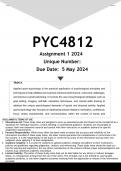Summary
A level Biology Circulatory System FULL A/A* SUMMARY notes
A level Biology Circulatory System FULL A/A* SUMMARY notes. Cheap and affordable notes. Easy to understand. Heart, circulation in animals and humans. Suitable for IB, GCSE, A-levels, Cambridge. Exam boards AQA, OCR A, OCR B, Eduqas, Cambridge, Edexcel. Notes typed by an A/A* student. Suitable for e...
[Show more]










